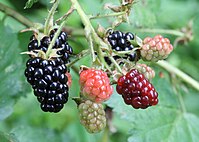
Photo from wikipedia
Abstract Primocane raspberry (Rubus idaeus L.) may produce crop on the lower part of the cane during the second year of its’ growth cycle, if the canes are retained over… Click to show full abstract
Abstract Primocane raspberry (Rubus idaeus L.) may produce crop on the lower part of the cane during the second year of its’ growth cycle, if the canes are retained over winter. We aimed to evaluate the floricane cropping potential and berry quality in seven primocane raspberry cultivars, which are too late for fall cropping in the Northern growing conditions. Long cane plants of these cultivars were produced, overwintered, and grown like floricane cultivars in a high tunnel. Harvesting floricane crop started in mid-June, and the length of the summer cropping season was between eight to 10 weeks. 'Joan J' and 'Imara' were the earliest cultivars, and 'Autumn Bliss' was the latest. Total floricane yield in most cultivars was between 1.7 to 2.0 kg/cane. ‘Autumn Treasure’ yielded significantly less, and ‘Autumn Bliss’ produced 2.5 kg berries /cane. The average berry size was 5 g, except in ‘Autumn Bliss’ and ‘Autumn Treasure’, which had smaller berries. The highest sugar content was observed in 'Kwanza' berries and the lowest in 'Polka'. High throughput phenotyping proved an effective tool for determining berry shape and color. ‘Kwanza’ berry color was the reddest, yellowest and lightest of all cultivars. Based on our results, growing primocane raspberry cultivars as long cane plants for production of summer crop is more reliable than growing them as fall cropping in short growing season conditions. The cultivars ‘Imara’ and ‘Kweli’ were the most promising in our experiment; they had a high yield potential and excellent berry quality.
Journal Title: Scientia Horticulturae
Year Published: 2021
Link to full text (if available)
Share on Social Media: Sign Up to like & get
recommendations!